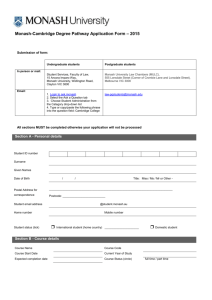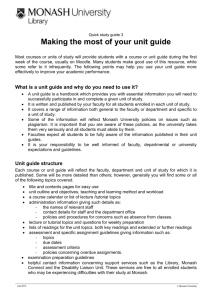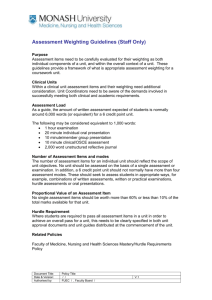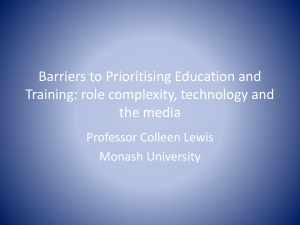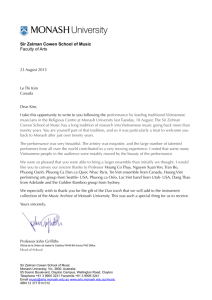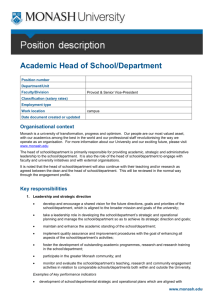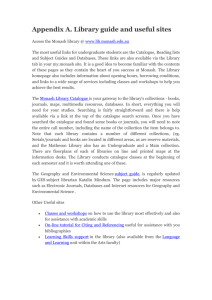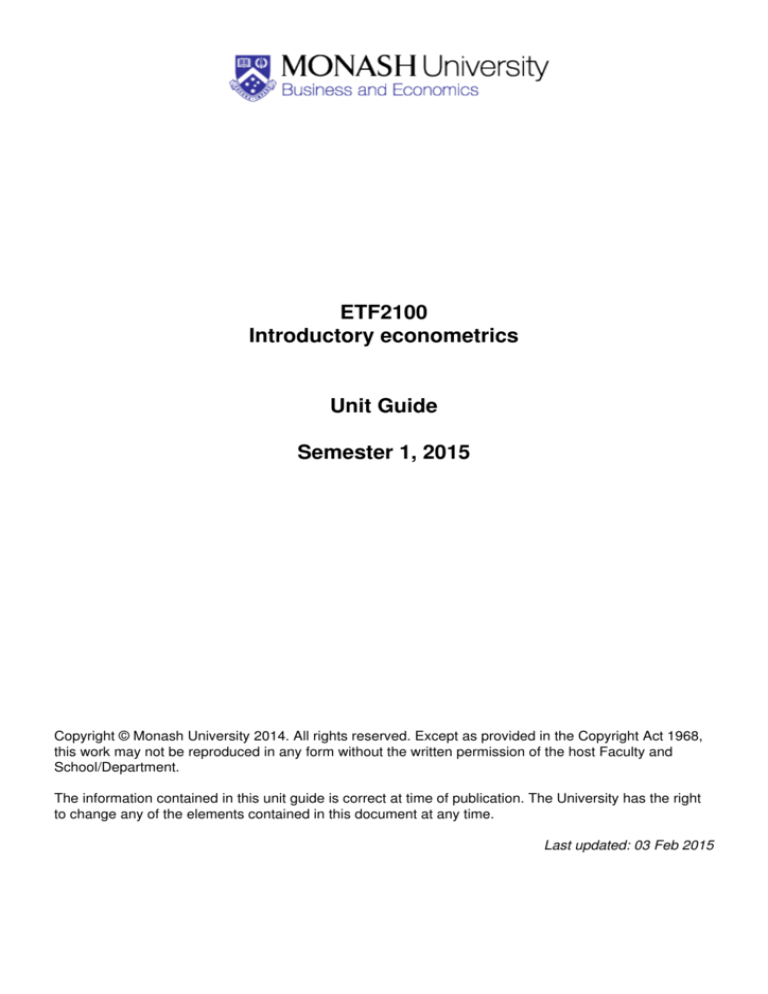
ETF2100
Introductory econometrics
Unit Guide
Semester 1, 2015
Copyright © Monash University 2014. All rights reserved. Except as provided in the Copyright Act 1968,
this work may not be reproduced in any form without the written permission of the host Faculty and
School/Department.
The information contained in this unit guide is correct at time of publication. The University has the right
to change any of the elements contained in this document at any time.
Last updated: 03 Feb 2015
Table of Contents
ETF2100 Introductory econometrics - Semester 1, 2015.......................................................................1
Mode of Delivery..............................................................................................................................1
Workload requirements....................................................................................................................1
Unit Relationships............................................................................................................................1
Prerequisites........................................................................................................................1
Prohibitions..........................................................................................................................1
Chief Examiner(s)........................................................................................................................................1
Campus Lecturer(s).....................................................................................................................................1
Caulfield...........................................................................................................................................1
Tutor(s)........................................................................................................................................................2
Caulfield...........................................................................................................................................2
Your feedback to Us....................................................................................................................................2
Previous Student Evaluations of this Unit....................................................................................................2
Academic Overview...................................................................................................................................3
Learning Outcomes.........................................................................................................................3
Unit Schedule.............................................................................................................................................4
Teaching Approach..........................................................................................................................4
Assessment Summary.....................................................................................................................5
Hurdle Requirements...........................................................................................................5
Second marking...................................................................................................................5
Return of final marks............................................................................................................5
Assessment criteria..............................................................................................................5
Assessment Requirements......................................................................................................................6
Assessment Tasks...........................................................................................................................6
Assessment task 1...............................................................................................................6
Assessment task 2...............................................................................................................6
Assessment task 3...............................................................................................................6
Examination(s).............................................................................................................................................6
Examination 1..................................................................................................................................6
Learning resources......................................................................................................................................7
Feedback to you..........................................................................................................................................7
Assignment submission...............................................................................................................................7
Hard copy submission.....................................................................................................................7
Online submission...........................................................................................................................7
Prescribed text(s) and readings.......................................................................................................7
Recommended text(s) and readings................................................................................................7
Other Information......................................................................................................................................8
Policies............................................................................................................................................8
Graduate Attributes Policy...................................................................................................8
Student Charter...........................................................................................................................................8
Student services..........................................................................................................................................8
Monash University Library...........................................................................................................................8
Moodle 2......................................................................................................................................................8
Disability Liaison Unit..................................................................................................................................9
ETF2100 Introductory econometrics - Semester 1, 2015
Econometrics is a set of research tools employed not only in economics but also in business disciplines.
This unit covers the basic tools for estimation in the context of simple and multiple linear regression, the
sampling properties of the least squares estimator, statistical inference and hypothesis testing. It also
covers regression with dummy variables, model specification issues and estimation problems when least
squares assumptions are violated. EViews is used as the software package.
Mode of Delivery
Caulfield (Day)
Workload requirements
Minimum total expected workload to achieve the learning outcomes for this unit is 144 hours per
semester typically comprising a mixture of scheduled learning activities and independent study.
Independent study may include associated readings, assessment and preparation for scheduled
activities. The unit requires on average three/four hours of scheduled activities per week. Scheduled
activities may include a combination of teacher directed learning, peer directed learning and online
engagement.
See also Unit timetable information
Unit Relationships
Prerequisites
Students must have completed ETX1100 or equivalent before undertaking this unit or must be enrolled in
course 3822 or 4412.
Prohibitions
ETC2410, ETC3440, ECC2410
Chief Examiner(s)
Professor Duangkamon Chotikapanich (First semester)
Professor Param Silvapulle (Second semester)
Campus Lecturer(s)
Caulfield
Professor Duangkamon Chotikapanich
1
ETF2100 Introductory econometrics - Semester 1, 2015
Tutor(s)
Caulfield
Dr Ari Handayani
Campus: Caulfield
Phone: +61 3 990 34349
Email: Ari.Handayani@monash.edu
Mr David Gunawan
Campus: Caulfield
Phone: +61 3 990 34530
Email: David.Gunawan@monash.edu
Your feedback to Us
Monash is committed to excellence in education and regularly seeks feedback from students, employers
and staff. One of the key formal ways students have to provide feedback is through the Student
Evaluation of Teaching and Units (SETU) survey. The University’s student evaluation policy requires that
every unit is evaluated each year. Students are strongly encouraged to complete the surveys. The
feedback is anonymous and provides the Faculty with evidence of aspects that students are satisfied
and areas for improvement.
For more information on Monash’s educational strategy, see:
www.monash.edu.au/about/monash-directions/ and on student evaluations, see:
www.policy.monash.edu/policy-bank/academic/education/quality/student-evaluation-policy.html
Previous Student Evaluations of this Unit
If you wish to view how previous students rated this unit, please go to
https://emuapps.monash.edu.au/unitevaluations/index.jsp
2
Academic Overview
Learning Outcomes
The learning goals associated with this unit are to:
1. apply econometric tools to modelling, estimation, inference, and forecasting in the context of real
world economic and business problems
2. formulate and test hypotheses about the relationships between variables
3. understand the nature and consequences of violation of the classical assumptions and know how
to test for violations
4. apply the skills and knowledge from the unit to real situations in business and economics
5. demonstrate the ability to generate and analyse EViews computer output for business and
economic applications.
3
Unit Schedule
Week
Activities
0
Assessment
No formal assessment or activities are
undertaken in week 0
1
Introduction: econometrics, data. Simple Linear
Regression (SLR): assumptions. Required reading:
Chapters 1 and 2.
2
SLR continued: least squares (LS) estimation,
interpretation, prediction, repeated sampling,
Gauss-Markov theorem, probability distributions of the
LS estimators, the error term. Required reading:
Chapter 2.
3
Interval estimation and hypothesis tests: t-distribution,
null and alternative hypotheses, test statistic, one and
two tail tests, level of significance, p-value, confidence
intervals. Required reading: Chapter 3 and 4.
4
Prediction, Goodness-of-fit, scaling, functional form.
Required reading: Chapters 4 and 5.
5
Multiple Linear Regression (MLR): assumptions, least Assignment 1
squares estimation, interpretation. Required reading:
Chapter 5.
6
Hypothesis tests, t- and F-tests, Goodness of fit,
omitted variables, irrelevant variables, RESET test.
Required reading: Chapters 5 and 6.
7
Further Inference in Multiple Regression Model
Violating MLR assumptions: collinearly,
heteroskedasticity, autocorrelation. Required reading:
Chapter 6.
8
Using Indicator Variable. Required reading: Chapter 7.
9
Heteroskedasticity. Required reading: Chapter 8
10
Heteroskedasticity (continued) and Autocorrelation.
Required reading: Chapter 9
11
Autocorrelation. Required reading: Chapter 9
12
Autocorrelation (continued)+ Brief revision
Assignment 3
SWOT VAC
No formal assessment is undertaken
SWOT VAC
Examination period
LINK to Assessment Policy:
http://policy.monash.edu.au/policy-bank/
academic/education/assessment/
assessment-in-coursework-policy.html
Assignment 2
Teaching Approach
4
Unit Schedule
Assessment Summary
Within semester assessment: 35%
Examination: 65%
Assessment Task Value
Due Date
Assignment 1
10%
Week 5
Assignment 2
15%
Week 9
Assignment 3
10%
Week 12
Examination 1
65%
To be advised
Hurdle Requirements
There is a hurdle requirement in this unit. Students are required to achieve at least 48% in the final
examination. Where a student fails the unit solely because of failure to satisfy the hurdle requirement a
maximum mark of 48% will be returned for the unit.
Second marking
Where an assessment task is given a fail grade by an examiner, that piece of work will be marked again
by a second examiner who will independently evaluate the work, and consult with the first marker. No
student will be awarded a fail grade for an assessment task or unit without a second examiner confirming
the result.
Note: Exceptions to this are individual pieces of assessment contributing 10% or less of the final mark,
unless the total of such pieces exceeds 30% of the final mark.
Return of final marks
Faculty policy states that 'the final mark that a student receives for a unit will be determined by the Board
of Examiners on the recommendation of the Chief Examiner taking into account all aspects of
assessment'.
The final mark for this unit will be released by the Board of Examiners on the date nominated in the
Faculty Calendar. Student results will be accessible through the my.monash portal.
Assessment criteria
Assessment Criteria Grading Descriptors available at:
http://www.buseco.monash.edu.au/esg/agu/policies/assessment.html.
5
Assessment Requirements
Assessment Tasks
•
Assessment task 1
Title:
Assignment 1
Due date:
Week 5
Details of task:
Weighting/Value:
10%
Estimated return date:
•
Assessment task 2
Title:
Assignment 2
Due date:
Week 9
Details of task:
Weighting/Value:
15%
Estimated return date:
•
Assessment task 3
Title:
Assignment 3
Due date:
Week 12
Details of task:
Weighting/Value:
10%
Estimated return date:
Examination(s)
• Examination 1
Weighting:
65%
Length:
2 hours
Type (open/closed book):
Closed book
Hurdle requirements:
The Pass mark in this unit is 50% overall. Students must score at least 48% in the final
examination in order to qualify for a Pass in the unit.
6
Assessment Requirements
A student's final mark is normally the sum of the marks obtained in all of the individual
assessment items in the unit. Where a student fails the unit solely because of failure to
satisfy the hurdle requirement a maximum mark of 48 will be returned for the unit.
Electronic devices allowed in the exam:
calculator
Learning resources
Monash Library Unit Reading List (if applicable to the unit)
http://readinglists.lib.monash.edu/index.html
Feedback to you
Types of feedback you can expect to receive in this unit are:
• Solutions to tutes, labs and assignments
Assignment submission
Hard copy submission
All assignments are to be submitted to the lecturer's mailbox on level 5, Building H.
Online submission
If Electronic Submission has been approved for your unit, please submit your work via the learning
system for this unit, which you can access via links in the my.monash portal.
Prescribed text(s) and readings
Hill, R.C., W.E. Griffiths, and G.C. Lim, Principles of Econometrics, 4th edition: Wiley2010.
This prescribed text is available from the bookshop and the library. It will be sold as a package with
Using EViews for Principles of Econometrics: which contains a student version of EViews 7 so that
students can install and use on their personal computers.
Recommended text(s) and readings
Wooldridge, J.M., Introductory Econometrics: A Modern Approach, 4th Edition, South-Western Cengage
Learning 2009.
Gujarati, D.N., Basic Econometrics, 4th edition: McGraw Hill 2002.
7
Other Information
Policies
Monash has educational policies, procedures and guidelines, which are designed to ensure that staff and
students are aware of the University’s academic standards, and to provide advice on how they might
uphold them. You can find Monash’s Education Policies at:
www.policy.monash.edu.au/policy-bank/academic/education/index.html
Key educational policies include:
• Student Academic Integrity Policy and Student Academic Integrity: Managing Plagiarism and
Collusion Procedures ;
• Assessment in Coursework Programs;
• Special Consideration;
• Grading Scale;
• Discipline: Student Policy;
• Academic Calendar and Semesters;
• Orientation and Transition; and
• Academic and Administrative Complaints and Grievances Policy.
Graduate Attributes Policy
http://www.policy.monash.edu/policy-bank/academic/
education/management/monash-graduate-attributes-policy.html
Student Charter
www.opq.monash.edu.au/ep/student-charter/monash-university-student-charter.html
Student services
The University provides many different kinds of support services for you. Contact your tutor if you need
advice and see the range of services available at http://www.monash.edu.au/students
Monash University Library
The Monash University Library provides a range of services, resources and programs that enable you to
save time and be more effective in your learning and research. Go to www.lib.monash.edu.au or the
library tab in my.monash portal for more information.
Moodle 2
All unit and lecture materials, plus other information of importance to students, are available through the
virtual learning environment Moodle site. You can access Moodle via the my.monash portal.
Where to go for help
If you're stuck, confused or simply not sure how to approach Moodle, there are a number of Moodle
resources that you can tap into.
8
Other Information
Disability Liaison Unit
Students who have a disability or medical condition are welcome to contact the Disability Liaison Unit to
discuss academic support services. Disability Liaison Officers (DLOs) visit all Victorian campuses on a
regular basis.
• Website: http://www.monash.edu/equity-diversity/disability/index.html
• Telephone: 03 9905 5704 to book an appointment with a DLO;
• Email: dlu@monash.edu
• Drop In: Equity and Diversity Centre, Level 1, Building 55, Clayton Campus.
9

